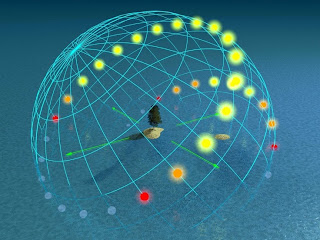Tyrrhenian Sea and Solstice Sky Credit & Copyright: Danilo Pivato, Source: apod.nasa.gov via minouette on Pinterest
The length of days varies little at the equator, and in the high arctic and antarctic we have the midnight sun in summer and no sun over the horizon in winter. Surprisingly, we can use a Ptolemaic idea to explain this. In Ancient Greece, they imagined that the objects observed in the sky were placed on a series of concentric spheres around the Earth. While we no longer imagine celestial bodies pinned to spheres of quitessence, the idea of the celestial sphere is still useful for mapping the apparent paths of any astronomical body in the sky. From our perspective on the surface of our planet, the sun traces a arc path across the sky, like that in the photo above. On any day this path is of course due to the rotation of the Earth around its axis. Over the course of the year, because of the tilt of the axis, the position of the arc varies as the earth completes its rotation along its elliptical path around the sun. At the equator, the the path of the sun in the sky makes an untilted arc to the north or south of the celestial equator (the imaginary line cutting the imaginary sky sphere in half). As we move away from the equator, the relative path of the sun appears more and more tilted (directly proportional to latitude). This tilt means the paths of the sun at the extremes of the yearly orbit, the two solstices, are quite different lengths. Away from the equator, the apparent path of the sun is quite long (maximal, in fact) at the summer solstice and quite short at the winter solstice. The image below shows the extemes of the paths of the sun on the celestial sphere above a point at mid-latitudes. If you go to higher latitudes this tilt of the two extreme paths of the sun become more and more tilted until the winter path is entirely below the horizon.
There are other astronomical cycles which affect our Earth, but which are not easy for individuals to observe, because they are much longer than human lifespans. These are known as the Milankovitch cycles and include things like procession of the Earth's axis (which moves like the children's toy, a spinning top or gyroscope) over a cycle of roughly 26,000 years.
Different cultures have developped different calendars, often, if not exclusively, based on their astronomical observations. In ancient Mesoamerica, the Long Count calendar broke time into a variety of units, as we do (days, weeks, months, years, centuries, millenia, eons). They had K'in (one day), Winal (20 days), 1 Tun = 18 Winal (360 days, almost 1 year), 1 K'atun = 20 Tun (7200 days, almost 20 years), B'ak'tun = 20 K'atun (144,000 days or almost 394 years), Piktun = 20 B'ak'tun (2,880,000 days or roughly 7,885 years), Kalabtun = 20 Piktun (57,600,000 days or roughly 157,704 years), K'inchiltun = 20 Kalabtun (1,152,000,000 days or roughly 3,154,071 years), Alautun = 20 K'inchiltun (23,040,000,000 days or roughly 63,081,429 years). Today happens to be the end of a B'ak'tun, which while nifty, it is not the end of the Mayan calendar. In the Mayan notation this day would be 13.0.0.0.0 which would have last occurred at the mythical creation day of this the fourth world, Monday, Aug 11, 3114 BCE (which is no more accurate, of course, than Bishop Usher's date, since of course, our planet is roughly 4.2 billion years old). The image at left shows the east side of stela C, Quirigua with mythical creation date in 13 (or 0) baktun, 0 katun, 0 tun, 0 uinal, 0 kin, 4 Ahau and 8 Cumku and corresponds to August 11, 3114 BCE in the Gregorian calendar (via wikipedia). Now previous worlds in the Mayan mythology only lasted 13 B'ak'tun, but there are inscriptions which refer to the end of the Piktun, which will not occur until 13 October 4772, so it's clear they assumed the world would be around a lot longer than this one solstice. So, if you would like to celebrate, celebrate the lengthening of days (at least here in the Northern Hemisphere), or go ahead and celebrate the end of the Mayan B'ak'tun as a notable date to a fascinating culture, or with tongue planted firmly in cheek, the bizarre variation on millennial pop culture myths of the end of days. Strange eschatological misconceptions seem like as good an excuse for a party as any. It'll be a while until we have the next prediction of an apocalypse.
(x-posted to minouette)














